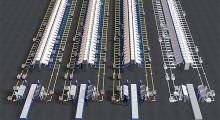DETROIT—At Automate 2022 here last week, mobile robot providers took center stage alongside industrial robot arm makers and component vendors. Zebra Technologies Corp. demonstrated its systems and discussed the best appoaches to applying automation.
While 65% of the robots in the U.S. are used by the automotive industry, collaborative robots are democratizing automation, said Jim Lawton, vice president and general manager for robotics automation at the company. He previously worked at Rethink Robotics, Universal Robots, and Fetch Robotics. Lincolnshire, Ill.-based Zebra acquired Fetch last year.
“Lean manufacturing practitioners used to hate automation because it was fixed infrastructure and needed custom deployment,” Lawton said during a session titled “Lessons From the Field: Understanding How, When, and Where to Apply Automation.”
“Now, with more flexible AMRs [autonomous mobile robots], we can identify workflows at the start,” he said. “There's a lot of interest in picking.”
Drivers to automaton
An informal poll conducted by Robert Huschka, vice president of education strategies at the Association for Advancing Automation (A3), the host of the event, found that most of the session audience consisted of robotics novices.
As several other speakers at Automate noted, online ordering and labor shortages have driven companies to adopt automation, said Lawton. “By most accounts, e-commerce growth accelerated by five to seven years in just the past two,” he said.
Lawton also cited a case where two temp firms in Florida were hiring manual pickers with high school diplomas at $25 per hour.
“It takes six to eight weeks to train a picker to be productive, but many quit after a company has already invested two weeks,” he said. “For an RFP [request for proposals] out to 3PL [third-party logistics] providers, all of the respondents included automation as a competitive advantage.”
Waytek, a distributor of electrical components, wanted to grow beyond 800 orders per day and its conventional conveyors. Fetch automated three workflows with point-to-point systems, according to Lawson:
- Scheduling—robots came to pick stations every 15 minutes
- Inbound from receiving to picking
- AMRs handled trash and dunnage
With a low capital expenditure or CapEx and a three-day installation, Waytek increased productivity, doubled throughput, and reclaimed up to 15% of its floor space, said Lawton.
Robot deployments accelerate with demand
“In many cases, people are skipping the proofs of concept or pilots and are moving straight into deployment of robots,” Lawton said. “They need to get systems in before peak season starts in September or October.”
“Compared with three years ago, people have moved from curiosity about robots to recognizing where they can add value. I've never seen this level of urgency,” he told Robotics 24/7. “Our prospects here have included 3PLs, retailers with warehouses, and some manufacturers.”
However, companies should think about where they're applying automation, he explained. “What are people good at, and what are robots good at?” asked Lawton. “Up to 50% of the time spent in manual picking is in travel, and robots have limitations in grasping, perception, and judgement.”
“With zone-based each picking, FlexShelf optimizes order and batch picking to carts,” he added. “Humans aren't going anywhere anytime soon—for example, you might want a bathing suit and a surfboard at the same time.”
“We still have to demonstrate the value of automation. Some of that value is in having orchestration software that optimizes both people and machines in an end-to-end process,” said Lawton. “We make it possible to program complex tasks with visual blocks and a drag-and-drop interface.”
“Customers have been asking about ease of use and interoperability, concerns that have been around for years for robot arms versus AMRs,” he said. “They want flexible, fast deployment, and FetchCore is best in class. So much of the emphasis is on fulfillment, and we can deploy tens to thousands of robots in a single implementation.”
“There is also some interest in case picking, and with 61,000 forklift accidents per year, on improving worker safety.”
“It's a question of how to bring robotics capabilities that unburden the user,” he said. “You shoud simplify processes, engage the team, and remember that collaborative robots are more than just robot arms and legs. There's also robotics as a service [RaaS].”
Zebra builds vision, automation portfolio
Also last week, Zebra said it has completed its $875 million acquisition of Matrox Electronic Systems Inc., a developer of machine vision components, software, and systems. The company said Matrox Imaging will complement its automation and vision offerings, as well as its new fixed industrial scanning portfolio and recent acquisitions of Adaptive Vision and Fetch Robotics.
“I expect additional consolidation in the market,” said Lawton. “It was a seller's market in 2021, and it's a buyer's market in 2022. VCs [venture capital firms] are said to be driven by greed or fear, and now it's fear. The industry has dumped too much engineering on customers, and we need to create more productized solutions.”
“Solutions should be easy to deply by those who understand the processes,” he said. “Zebra wants to help its customers be successful, and that's what they expect.”
About the Author
Follow Robotics 24/7 on Linkedin
Article topics
Email Sign Up


















